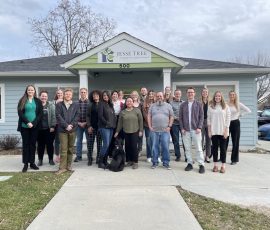Established in 2006, the Vision and Call internship program is built on the belief that life’s longer lessons, the ideas that shape commitment and souls, are often best learned through an apprenticeship experience and worked out through a community of mentors and peers. Each internship experience is expected to incorporate six essentials elements. In a special blog post series, current Vision and Call organizational leaders share their insight into the value and importance of these essential elements.
Today’s guest post is by Rob McCloskey, Director of Operations, Q Ideas. Rob speaks to us about Essential 1- A Careful Selection Process.

“It is the little details that are vital. Little things make big things happen.”
John Wooden
Defining the process for how you select candidates is one of the most important elements of your entire internship program. Small choices you make at the very beginning of this path can set a trajectory that can make the difference between onboarding a significant contributor who helps shape and grow your organization in positive ways or hiring a more mediocre team member who does not move the needle significantly.
When you bring a new individual into an organization, they inherently have an impact on the overall work environment whether they are an Executive Director, an Administrative Assistant or an Intern. This is particularly true in the nonprofit sector where the entire team may only be a handful of individuals. Interns are no different from paid staff in this regard as their personality, work style and capacity will change the dynamic of your team’s day-to-day experience.
At the same time, this opportunity is a major life moment for the individuals you interview and hire into your internship program. Those who are hired will spend a significant amount of their time learning from your team and working on your mission. For many, this will be one of their first career-defining moments and help shape their professional trajectory. Those who apply but are not ultimately selected will have invested considerable time preparing for the interview process and may be left questioning why they did not make the final cut.
This is why it is important to be intentional in how you walk through the application and selection process for your internship program. Like most aspects of business, investing time upfront in thoughtful planning will deliver a much more valuable result to those involved compared with a hurried approach that only looks at surface level needs. In some instances, organizations will recognize a desire to bring an intern on board, but not have a clear purpose or goal for the intern’s time. When the internship concludes, the organization may feel disappointed in their outcomes as no clear goals were articulated. Similarly, the intern may feel underwhelmed by their experience and unsure of the skills they have to bring forth in the work place.
Organizations can inoculate against these sorts of negative outcomes and ensure a much more positive, constructive experience for all involved by following a few principles from the outset.
- Identify the purpose of this internship. What value do you hope your intern will bring to your organization? Are there specific projects you want them to complete or are you hoping they will introduce new thinking to your team?
- Consider who will be working with this individual and ensure they are included in the interview process. Treat this hire like any other new staff member and make sure all potential managers have the chance to weigh in on their inclusion with the team.
- Look through the lens of the intern and consider what they may want or need to have a successful experience.
- Cast your net wide. When our calendars get full, it can be easy to collect a handful of qualified candidates and focus your selection process on these few names. But by opening your process and seeking to recruit the most candidates as possible, you provide your organization with the BEST opportunity to find the strongest player for your needs. Make efforts to expand your search by leveraging your network and recruiting platforms to open your recruiting process broadly.
- Consider the matter of “fit.” Organizations can take criticism for denying a job opportunity for the vague reason of not being a “cultural fit.” However, how personalities and work styles mesh is a reality of a successful organization. Rather than leave it to some undefined “feeling” by your hiring team, take time to think about the qualities and characteristics of the individual who will be successful in this role. Do you need someone who is self-directed or group oriented? Is your team naturally more quiet and reserved or boisterous and energetic? Make this clear during the interview process.
- Be clear on long-term expectations. What would success look like at key milestones of this internship? Is there a path through this internship to a full-time role or is the expectation that this intern would need to find employment when it concludes?
- A bonus of committing to this type of robust search process is the confidence it will inspire in the intern you ultimately select. Rather than a simple resume review and quick interview, by conducting a thorough process that digs into the deep layers of who the candidate is, the individual you hire will feel more invested in your organization and more confident in their ability to excel.
Every journey begins with a single step. When introducing an internship program, that first step is how you approach the selection process. Investing time and thought up front will set you and your new hire up for maximum success.
Photo by Christina @ wocintechchat.com on Unsplash








